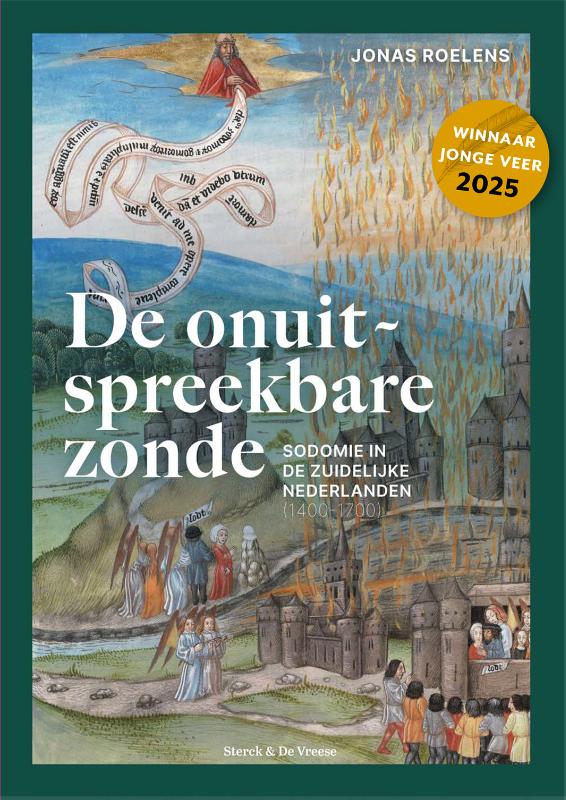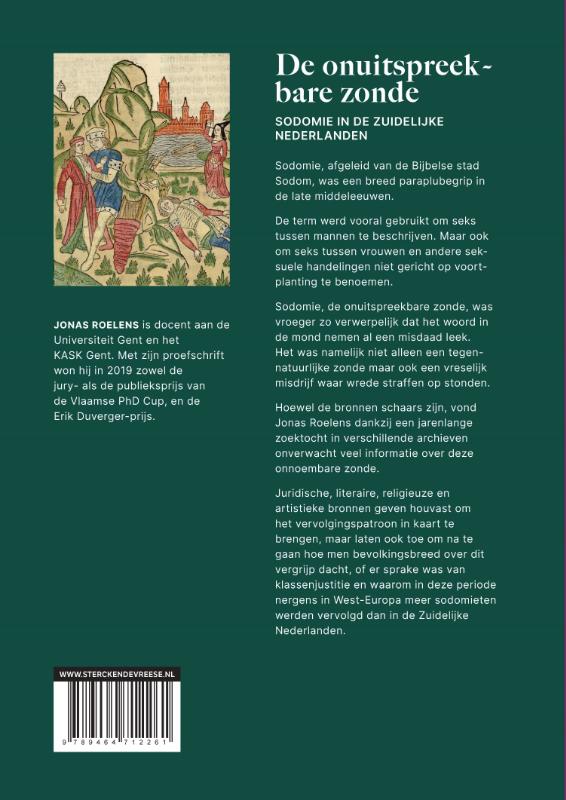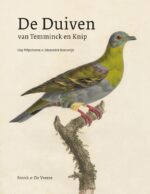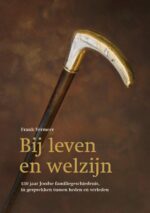De onuitspreekbare zonde
€ 27,90
Sodomie, afgeleid van de Bijbelse stad Sodom, was een breed paraplubegrip in de late middeleeuwen.
De term werd vooral gebruikt om seks tussen mannen te beschrijven. Maar ook om seks tussen vrouwen en andere seksuele handelingen niet gericht op voortplanting te benoemen.
Sodomie, de onuitspreekbare zonde, was vroeger zo verwerpelijk dat het woord in de mond nemen al een misdaad leek. Het was namelijk niet alleen een tegennatuurlijke zonde maar ook een vreselijk misdrijf waar wrede straffen op stonden.
Hoewel de bronnen schaars zijn, vond Jonas Roelens dankzij een jarenlange zoektocht in verschillende archieven
onverwacht veel informatie over deze onnoembare zonde.
Juridische, literaire, religieuze en artistieke bronnen geven houvast om het vervolgingspatroon in kaart te brengen, maar laten ook toe om na te gaan hoe men bevolkingsbreed over dit vergrijp dacht, of er sprake was van klassenjustitie en waarom in deze periode nergens in West-Europa meer sodomieten werden vervolgd dan in de Zuidelijke Nederlanden.
JONAS ROELENS is docent aan de Universiteit Gent en het KASK Gent. Met zijn proefschrift won hij in 2019 zowel de jury- als de publieksprijs van de Vlaamse PhD Cup, en de Erik Duverger-prijs.
Gerelateerde boeken
-
24 uur in het oude Rome
€ 21,90Stap terug in de tijd en volg gedurende een etmaal 24 inwoners van de eeuwige stad in het jaar 137 na Christus. Zo krijg je een verrassend compleet beeld van hoe het dagelijks leven was in het Rome van keizer Hadrianus. Lees de spannende verhalen van onder anderen een bakker, een moeder, een senator, een slavin, een gladiator, een prostituee en een scholier en tegelijkertijd allerlei minder bekende wetenswaardigheden over het
oude Rome.Door de vele citaten uit de klassieke literatuur, waaronder zelfs enkele recepten, en
extra historische informatie komt een tijd die nog altijd tot de verbeelding spreekt, tot leven. -
Bij leven en welzijn
150 jaar Joodse familiegeschiedenis, in gesprekken tussen heden en verleden€ 25,00Bij leven en welzijn
€ 25,00Frank Vermeer neemt de lezer mee naar de wereld van zijn voorouders. Zo voert hij in het Alsterpavillon en op de Joodse begraafplaats Ohlsdorf in Hamburg gesprekken met zijn overgrootvader Abraham Salomon Levy. In zijn eigen tuin in Winsum spreekt hij met zijn overgrootmoeder Rosalie Vos-Boasson. Oudoom Louis Levy overwint zijn schroom en verhaalt over zijn ontwikkeling als homoseksuele man.
Zij vertellen over hun levens in de negentiende eeuw en de eerste decennia van de twintigste eeuw in de Joodse gemeenschappen in Hamburg, Middelburg en Assen. Levens, gekenmerkt door welzijn, hoop, assimilatie en emancipatie. Nu en dan steekt fel antisemitisme de kop op.
Als Hitler aan de macht komt zijn de jaren van ‘leven en welzijn’ ten einde. Grootvader Isidor Vos, grossier in Assen en jarenlang politiek actief, vertelt over de dreigende jaren dertig en de smartelijke oorlogsjaren die eindigen in Sobibor.Jan Vermeer en Rosalie Vos, de ouders van de auteur, vormen een ‘privilegierte Mischehe’: een ‘bevoorrecht gemengd huwelijk’ waarvan de Joodse partner niet gedeporteerd zou worden. De kans op lijfsbehoud is nog groter als het echtpaar een kind heeft. In 1943 wordt hun dochter geboren, die echter kort daarop al overlijdt. Wat nu? De dramatische gebeurtenissen volgen elkaar snel op.
Na de oorlog breekt een nieuwe tijd aan van leven en welzijn. Maar ook ontbrandt ‘De strijd om het Joodsche kind’.
Na rechtsherstel komt de familie weer in het bezit van het geconfisqueerde huis van grootvader Isidor Vos. De auteur vertelt over zijn recente ontmoeting met de kinderen van de ‘foute’ Nederlandse vrouw die in de oorlog dat huis van de Duitsers kocht.‘Bij leven en welzijn’ is een indrukwekkende en met vlagen lichtvoetige familiegeschiedenis. Het is een gewaagd mengsel van authentieke stukken en nauwkeurige historische reconstructie, aangevuld met literaire fictie, alles geplaatst tegen de achtergrond van het begrip menselijke waardigheid. Doordat hij de historische feiten verweeft met fictieve gesprekken met zijn voorouders, brengt Frank Vermeer de Joodse geschiedenis van zijn familie weer tot leven.
Frank Vermeer (1949) was advocaat in Groningen en docent bestuursrecht aan de Rijksuniversiteit Groningen. Daar promoveerde hij in 2010 op een bestuursrechtelijke onderwerp. Van jongs af aan heeft hij zich betrokken gevoeld bij de (oorlogs)geschiedenis van zijn Joodse familie. Van 2016 tot 2023 was hij voorzitter van het Oorlogs- en Verzetscentrum Groningen en sinds 2016 is hij voorzitter van de stichting Behoud Synagoge Winsum.
-
Hannekemaaiers en Kiepkerels
€ 16,90Vanaf de Gouden Eeuw tot aan de Eerste Wereldoorlog kwamen elk voorjaar duizenden seizoenarbeiders vanuit Duitsland naar Nederland om de boeren te helpen bij de hooioogst. Ze werden hannekemaaiers, mieren of poepen genoemd. Individueel of in groepjes boden ze zich aan. Boeren in het noorden hadden gemiddeld twee tot vier hannekemaaiers aan het werk. Sommigen kwamen jaar na jaar terug bij dezelfde boer. Anderen handelden in linnenwaren. Deze ‘lapkepoepen’ vormden de basis van talloze winkels en bedrijven in kleding en textiel die nu nog steeds in Nederland aanwezig zijn.
In Hannekemaaiers en Kiepkerels beschreef Kornelis Mulder (1916-1978) de geschiedenis, de herkomst en de invloed van deze seizoenarbeiders.





